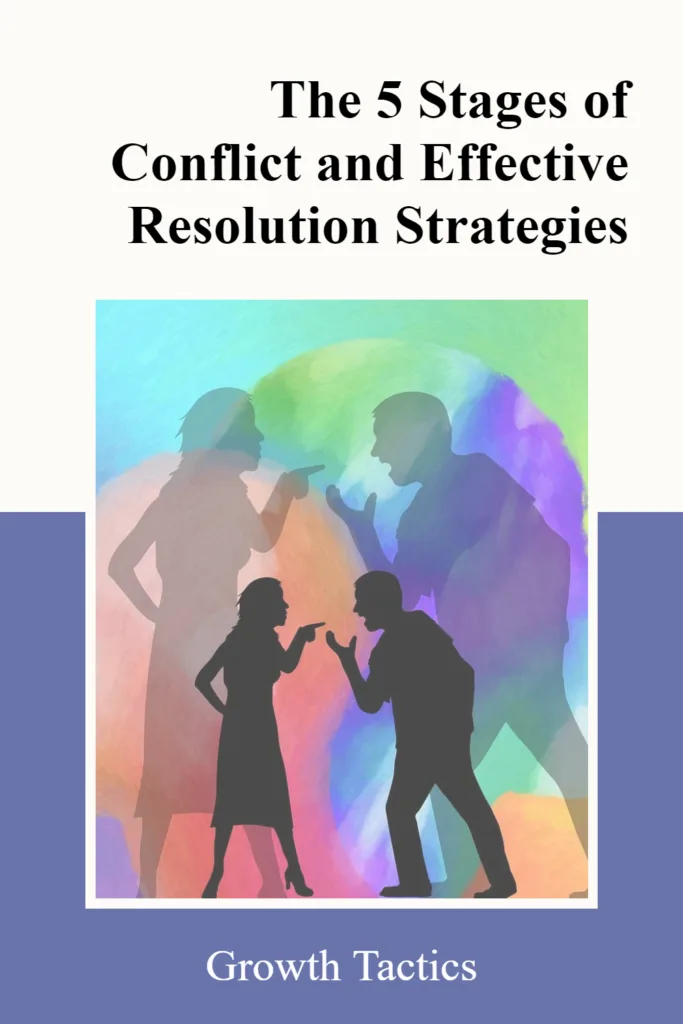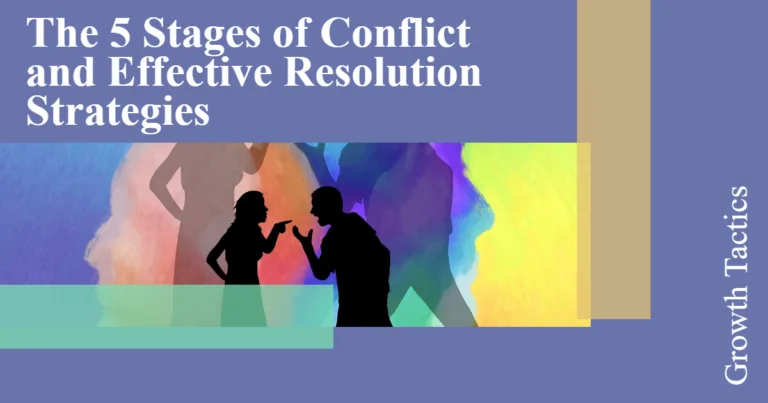Have you ever felt stuck in a never-ending argument? I sure have. But here’s the thing: conflict doesn’t have to be a bad thing. In fact, it can lead to growth and positive change when handled right. Let’s explore the 5 stages of conflict and learn how to navigate them like a pro.
Jump To Section
The Latent Stage: The Calm Before the Storm
What is Latent Conflict?
Ever had that feeling in your gut that something’s off, but you can’t quite put your finger on it? That’s what we call latent conflict. It’s like a tiny spark that could either fizzle out or turn into a roaring fire. I’ve learned it’s better to deal with that spark before it gets out of hand.
Spotting the Signs
Latent conflict is sneaky. It’s there, lurking beneath the surface, waiting to pop up when you least expect it. Think of it as the seeds of disagreement that haven’t sprouted yet. But don’t worry, I’m here to help you spot those seeds and nip them in the bud.
Here are some signs to watch out for:
- Tension in the air that you can’t explain
- Sudden silence when certain topics come up
- People avoid each other more than usual
- Subtle eye rolls or sighs in meetings
- A general feeling of unease in your team or family
Addressing Issues Early
Now, you might be thinking, “Okay, I see the signs. But what do I do about it?” Well, I’ve got some tricks up my sleeve that have worked wonders for me.
First off, trust your gut. If something feels off, it probably is. Don’t brush it aside. Instead, take a moment to reflect on what might be causing that feeling. Is there a change in your environment? Has someone’s behavior shifted?
Next, open up those lines of communication. I can’t stress this enough. Talk to people. Ask how they’re doing. Show genuine interest in their thoughts and feelings. You’d be amazed at how often a simple conversation can prevent a full-blown conflict.
Your Call to Action
Remember, addressing issues early is like weeding your garden. It’s easier to pull out a tiny weed than to deal with an overgrown mess later. So, be proactive. If you notice any of those signs I mentioned, don’t wait. Tackle them head-on with kindness and understanding.
Here’s your call to action: This week, pay close attention to your environment. Look for those subtle signs of latent conflict. If you spot any, take a deep breath and start a conversation. Your purpose? To create a more harmonious space where everyone feels heard and valued.
The Perceived Stage: Something’s Not Right
Remember when we talked about latent conflict? Well, now we’re moving into the perceived stage. This is where things start to feel a bit off, and you can’t ignore it anymore. Let’s dive in and figure out how to handle this tricky situation.
Recognizing When Conflict Exists
Honestly, I’ve missed the signs of conflict, which typically doesn’t end well. That’s why I want to help you spot it early. You might notice people avoiding eye contact, speaking in clipped tones, or even gossiping more than usual. Trust your gut, if something feels wrong, it probably is.
The Role of Perception in Disagreements
Here’s the thing about perception: it’s unique to each person. What I see as a problem might not bother you at all. I once had a coworker who thought I was upset with her when really, I was just stressed about a deadline. Our different perceptions almost caused a real conflict!
Remember, we all see the world through our own lens. That’s why it’s crucial to ask questions and listen actively. Don’t assume you know what others are thinking or feeling.
Tips for Improving Emotional Intelligence
I’ve found that boosting my emotional intelligence has been a game-changer in handling conflicts. Here are some tips that have worked for me:
- Practice self-awareness. Take a moment each day to check in with yourself.
- Put yourself in others’ shoes. Try to understand their perspective.
- Manage your emotions. It’s okay to feel upset but don’t let it control you.
- Listen more than you speak. You’d be amazed at what you can learn.
Your Purpose-Driven Action
Now, it’s your turn to put this into practice. This week, I challenge you to really tune into the emotions and perceptions of those around you. If you sense a conflict brewing, don’t shy away from it. Instead, approach it with curiosity and empathy.
Remember, your purpose here is to create a more understanding and harmonious environment. By improving your emotional intelligence and addressing conflicts early, you’re not just solving problems, you’re building stronger relationships and becoming a better leader.
The Felt Stage: Emotions Run High
Alright, let’s talk about the felt stage of conflict. This is where things get real, and emotions start to boil over. We’ve all been there, and I know it’s not easy. But don’t worry, we’re going to tackle this together.
Understanding the Emotional Impact of Conflict
Remember how we talked about perception in the last section? Well, now those perceptions are turning into strong feelings. You might feel angry, hurt, or even scared. That’s normal! I once had a disagreement with a team member that left me feeling frustrated for days. It’s important to recognize these emotions and understand that the other person is probably feeling them too.
Strategies to Manage Your Feelings
Here’s the thing: you can’t control how you feel, but you can control how you react. I’ve learned some tricks over the years that really help:
- Take a deep breath. It sounds simple, but it works.
- Count to ten before you respond. This gives you time to think.
- Write down your feelings. Sometimes, seeing them on paper helps.
- Go for a quick walk. Moving your body can clear your head.
Try these out and see which ones work best for you. We’re all different, and that’s okay!
How to Create a Safe Environment for Open Communication
Now, let’s talk about making it safe for everyone to speak up. I once worked with a leader who was great at this. She always started meetings by saying, “There are no bad ideas here.” It made a huge difference!
Here are some things you can do:
- Listen without interrupting. Show that you value what others say.
- Use “I” statements. Say “I feel” instead of “You make me feel.”
- Encourage everyone to share. Some people need a little nudge.
- Thank people for their honesty. It’s not always easy to speak up.
Your Purpose-Driven Action
Okay, here’s your challenge: This week, when you feel those emotions rising, try out one of the strategies we talked about. Then, think about how you can make your space safer for open talks.
The Manifest Stage: Conflict Comes to Light
Okay, folks, we’ve talked about feelings. Now, let’s see what happens when those feelings bubble up to the surface. Welcome to the manifest stage, where conflict becomes visible to everyone. I’ve been through this more times than I can count, and I’m here to help you navigate it.
Identifying Visible Signs of Conflict
You know that uneasy feeling in your gut when something’s off? Well, now it’s showing up in real life.
Here are some signs I’ve noticed:
- People avoid each other in the office
- Meetings get tense or super quiet
- Work quality drops
- There’s a lot of eye-rolling or sighing
I once had a team where two members stopped talking completely. That was a big red flag! Keep your eyes open for these signs.
Effective Tactics for Addressing Disagreements
Alright, you’ve spotted the conflict. Now what? Don’t worry, I’ve got some tricks up my sleeve:
- Address it head-on. I know it’s scary, but ignoring it won’t make it go away.
- Use “we” language. It’s not you vs. them, it’s all of us vs. the problem.
- Ask questions. Try “What do you think about…?” instead of making assumptions.
- Take breaks if things get heated. I once called a 5-minute timeout in a meeting, and it worked wonders!
Remember, the goal isn’t to win. It’s to solve the problem together.
The Importance of Finding Common Ground
Here’s a secret: even in the biggest fights, there’s usually something both sides agree on. Your job is to find it. I always start with our shared goals. Do we all want the project to succeed? Do we all care about our customers? Start there!
Finding common ground does two amazing things:
- It reminds everyone you’re on the same team
- It gives you a foundation to build solutions on
I once had two team members who couldn’t agree on anything. But they both loved our company’s mission. That became our starting point for working things out.
Your Purpose-Driven Action
Here’s your mission this week: Look around your workplace. Can you spot any signs of conflict? If you do, don’t panic. Instead, think about how you can use one of the tactics we talked about to address it.
Remember, your purpose here isn’t just to fix problems. It’s to build a stronger, more open team. By facing conflicts head-on and finding common ground, you’re not just solving today’s issue. You’re creating a better environment for everyone.
The Aftermath Stage: Resolution or Dissolution
Alright, folks, we’ve made it to the final stretch of our conflict journey. Let’s talk about what happens after the dust settles.
Exploring Possible Outcomes
So, what’s next? Well, there are usually two paths:
- Resolution: You’ve worked it out! The team’s stronger than ever.
- Dissolution: Sometimes, things just don’t work out.
I once had a team conflict that ended in resolution. We came out of it with better communication skills and a stronger bond. But I’ve also seen teams fall apart. Both outcomes taught me some valuable lessons.
Strategies for Conflict Resolution
Let’s focus on resolution because that’s what we’re aiming for.
Here are some tricks I’ve learned:
- Listen more than you talk. I mean really listen.
- Be willing to compromise. You might not get everything you want, and that’s okay.
- Focus on the future, not the past. Ask, “How can we work better together going forward?”
- Celebrate small wins. Did you agree on one thing? That’s progress!
Remember, resolution doesn’t mean everyone’s best friends. It means you can work together effectively.
Learning from the Experience
Here’s the secret sauce: whether you resolve the conflict or not, there’s always something to learn.
Ask yourself:
- What could I have done differently?
- What early warning signs did I miss?
- How can I use this experience to handle future conflicts better?
I once had a major disagreement with a coworker. Even though we patched things up, I learned I needed to speak up earlier when something bothered me. That lesson has served me well ever since.
Your Purpose-Driven Action
Now it’s your turn. Think about a recent conflict you’ve been part of or witnessed. How did it end? What did you learn from it?
Here’s your mission: Take one lesson from that experience and apply it this week. Maybe you’ll speak up sooner, or listen more carefully to a coworker. Whatever it is, use it to make your workplace better.
Remember, every conflict is an opportunity to grow, both as an individual and as a team.
Conclusion
Remember, conflict is a natural part of life. By understanding these stages and applying the strategies we’ve discussed, you’ll be better equipped to handle disagreements constructively. Don’t be afraid to face conflicts head-on. They’re opportunities for growth and positive change. So, the next time you find yourself in a dispute, take a deep breath and put these skills to work. You’ve got this!
FAQ
Q: What are the 5 stages of conflict?
A: The five stages of conflict include: 1) Latent Conflict, where a triggering event occurs; 2) Perceived Conflict, where parties involved recognize a disagreement; 3) Felt Conflict, where emotions become involved; 4) Manifest Conflict, where the conflict is openly expressed; and 5) Aftermath, which follows the resolution of the conflict.
Q: How can understanding the stages of conflict improve conflict management?
A: Understanding the stages of conflict allows individuals to identify the nature of the conflict early on, enabling them to apply effective conflict resolution strategies before the situation escalates. This insight can help maintain a harmonious and productive work environment.
Q: What role does mediation play in resolving conflicts?
A: Mediation is a conflict resolution strategy where a neutral third party, known as a mediator, helps the conflicting parties communicate and negotiate to reach a mutually beneficial outcome. This process can be particularly effective in the felt and manifest stages of conflict.
Q: What are some effective conflict resolution skills taught in online courses?
A: Online courses often cover various conflict resolution skills, such as active listening, empathy, negotiation techniques, and the ability to foster understanding among team members. These skills are essential for effectively managing conflict in the workplace.
Q: How can conflict styles affect the outcome of the conflict?
A: Different conflict styles, such as competing, accommodating, avoiding, collaborating, and compromising, can significantly influence the outcome of the conflict. Understanding these styles helps individuals choose the most effective approach to resolve conflicts.
Q: What is the importance of a conflict management plan?
A: A conflict management plan is vital as it provides a structured approach to addressing potential conflicts before they escalate. By outlining strategies for conflict resolution, teams can foster a more harmonious work environment and enhance overall productivity.
Q: What can be done to prevent misunderstandings that lead to conflict?
A: To prevent misunderstandings, it is essential to encourage open communication, clarify expectations, and actively listen to the perspectives of all parties involved. This proactive approach can help mitigate the risk of conflicts arising in the first place.
Q: How does the aftermath stage influence future conflicts?
A: The aftermath stage is crucial as it reflects on the resolution process and its effectiveness. Positive outcomes can foster trust and improve relationships among team members, while negative experiences may lead to lingering resentment, potentially escalating future conflicts.
Q: What are some strategies for resolving conflicts among team members?
A: Effective strategies for resolving conflicts among team members include encouraging open dialogue, facilitating mediation sessions, focusing on common goals, and employing collaborative problem-solving techniques. These approaches help to create a more cohesive and productive team dynamic.


